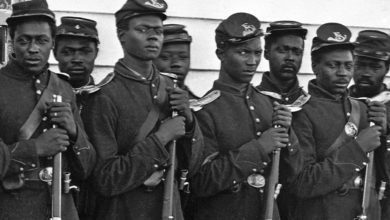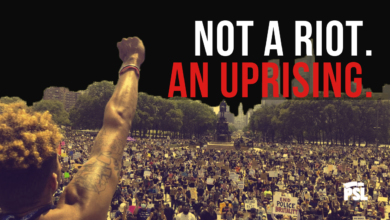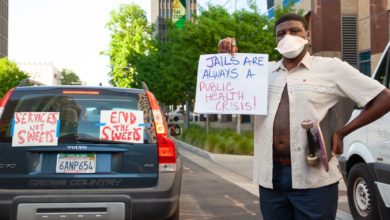Originally posted in 2013.
Every schoolchild in the United States is exposed at one point or another to this famous passage from the Declaration of Independence: “We hold these truths to be self-evident, that all men are created equal, that they are endowed by their Creator with certain unalienable Rights, that among these are Life, Liberty and the pursuit of Happiness.” It is often cited, especially around Independence Day celebrations, as proof of the United States’ supposed moral infallibility and noble commitment to democratic ideals.
But for the vast majority of people who were alive for the drafting of this founding document, this was hollow rhetoric. Women were treated as the property of their husbands and fathers and had almost no civil or political rights. Even many white males were denied access to formal political channels due to property requirements for suffrage, and poor farmers were largely left out of the post-independence redistribution of loyalist landholdings.
The emptiness of this proclamation, principally authored by Thomas Jefferson, a slaveowner and one of the new country’s most prominent racist ideologues, was particularly apparent to the nearly 20 percent of the population who were enslaved and the Indigenous peoples who saw no relief from genocidal colonial expansion.
At the same time, the bulk of the victorious colonist army was certainly not made up of wealthy merchants and parasitic slaveholders. Those from the ruling strata of society who led it—like George Washington—did so as part of the officer class with all the attendant material comforts. What motivated members of the oppressed classes to join and ultimately win the War of Independence?
It certainly was not as if pre-independence U.S. history was a picture of national unity; class struggle was waged throughout the colonies. New York and New Jersey were home to a series of revolts waged by tenant farmers against their landlords. A similar movement of poor farmers, called the Regulator Movement, challenged the landed gentry in North Carolina. Heroic uprisings carried out by the enslaved shook the slavocracy to its core.
But still, circumstances allowed for the formation of a cross-class alliance to challenge British rule. The political leadership of the independence movement came from the merchants and slaveholders, who resented taxes imposed by London and a prohibition on colonization past the Appalachians. The upper classes were politically alienated by the monarchy when it began dispersing institutions of local government and concentrating more and more power in the hands of direct representatives of King George III.
Although many enslaved Blacks understandably sympathized with the British, who promised freedom in return for loyalty to the crown, rather than join a war effort led by one of the largest slaveholders in the colonies, lower class whites and free Blacks were largely supportive of the struggle for independence. They suffered the most from rising prices associated with the infamous Stamp Act and residents of port cities, often home to the most militant patriots, faced the threat of impressment—being kidnapped and forced to join the British Navy.
The English monarchy was seen as a symbol of the opulence of the hated upper classes, and support for independence was used as an opportunity to attack the arrogant notion of divine right—that the rule of a wealthy minority headed by a royal family was the natural, God-given order of society.
What was the ideological basis for the unity of the pro-independence social alliance? Everyone involved recognized the right of revolution. Waging a war for total separation from the British Empire required a radical rupture with the old politics of unquestioning fealty promoted by the monarchy.
While the Declaration of Independence was full of hypocrisy, it also contained this very progressive passage, “[W]henever any Form of Government becomes destructive of these ends [life, liberty and the pursuit of happiness], it is the Right of the People to alter or to abolish it, and to institute new Government. … [W]hen a long train of abuses and usurpations, pursuing invariably the same Object evinces a design to reduce them under absolute Despotism, it is their right, it is their duty, to throw off such Government.”
The right of revolution today
This notion, that in the face of oppression revolution was both a right and a duty, broke with all existing political traditions and recognized that the masses of people were the true makers of history. From the perspective of the landed gentry and rising merchant class, this was a very dangerous idea, but to achieve their aim of independence the new ruling class of the United States had no choice but to recognize it.
For the hundreds of thousands of participants who threw themselves into the war effort in one capacity or another, the right of revolution was no academic concept. The fighters for independence were able to open up a political space to challenge all forms of injustice by militarily defeating those who they had been told represented their divinely ordained superiors.
After independence was secured from the British, the masses of people wasted no time in using this space to organize against their new oppressors. Deeply indebted small farmers in western Massachusetts carried out a major armed uprising, which came to be known as Shays’ Rebellion, against an impending wave of foreclosures. A mass abolitionist movement in the North, complementing the ongoing insurrectionary activity carried out by slaves in the South, came into being in part on the ideological foundation of the right of revolution.
This tradition persists throughout U.S. history to the present day. Whenever it became apparent that a particular form of oppression was rooted in the political and economic structure of society itself, mass movements could connect to a proud radical legacy rooted in the right of revolution. The labor, LGBT, immigrants’ rights, and women’s and Black liberation struggles are just a few examples of people’s movements that at certain points turned to revolutionary politics to combat a system that aimed to “reduce them under absolute despotism.”
The right of revolution is not just an abstract political concept; it is a law of history. Lasting progress is not the result of compromise or the apolitical pursuit of utopian ideals. Real change can come about when the ruling elements of society outlive their ability to contribute to humanity and are confronted by those who maintain the rulers’ absurd and opulent existence with their sweat and blood.
This contradiction has taken many forms, leading to gains in some places and retreats in others. As the oppressed begin to understand their role in history, the struggle becomes more and more intense as the oppressors desperately try to prolong their rule over society. Ultimately, this conflict is resolved in a revolution, the decisive moment when the future conquers the past and a new era of human history begins.
Time for a new revolution
There can be little doubt that the bankers and CEOs who hold power in society today constitute just such an outmoded and reactionary force that can only be displaced through revolution. They create nothing of value but control all of society’s wealth. They organize production solely to maximize profits, guaranteeing that enormous swaths of humanity live in poverty and that periodic economic crises will leave more and more people destitute. They deny a decent education to a huge layer of society, holding back innovation and stifling the vast creative potential of humanity.
To maintain their grip on society, the capitalists spread racism, sexism, homophobia and all other forms of bigotry imaginable to divide us and prevent us from realizing our strength. The police carry out campaigns of racist terror against communities of color and attempt to repress any attempts to challenge the status quo.
But in spite of this horrifying oppression, the future, in an objective sense, belongs to us. Their system continues to function solely by virtue of our labor. Once the poor and working people of the world become aware of this fact and organize on that basis, the system of exploitation that underscores every other injustice can be eliminated.
As one particularly visionary participant in Shays’ Rebellion put it, “The great men are going to get all we have and I think it is time for us to rise and put a stop to it, and have no more courts, nor sheriffs, nor [tax] collectors.”
These words ring just as true today as they did more than 200 years ago. But to get there, we have to exercise the right of revolution.





